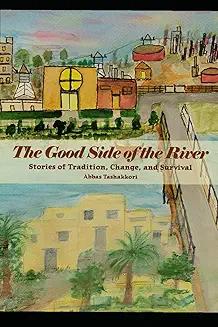
The Good Side of the River: Stories of Tradition, Change, and Survival Told by an Iranian-American immigrant, this is an emotionally engaging collection of stories chronicling seven decades of struggles and triumphs, from a childhood of poverty in Iran, and with parents who never went to school themselves, to professional success in American academia. It takes the reader along on a voyage through beautiful but impoverished ancient places and cultures to a modern and fast-changing world requiring personal sacrifices and risks to survive and adapt. The book also provides glimpses of life during some of the geopolitical turmoil of the past decades involving Iran and the U.S., such as the #Islamic Revolution, #hostage crisis of 1977, economic embargo, and the #Iran-Iraq war. Emotional and psychological costs of dealing with major changes during that voyage are discussed, including the immigration and change of citizenship, as well as three decades of working as a professor, researcher, writer, and administrator in the U.S.
At an academic level, this is a first-hand case study of how the “homeless mind” develops over time when individuals experience alienation (cultural homelessness, Berger, 1973) as a consequence of socio-cultural change, modernization, and social/geographic mobility. The book ends with a personal analysis of the emotional burdens of immigration, longing, guilt, anxiety, loneliness and depression, leaving it up to the reader to decide which side of the symbolic river was/is the “good” one.
Thank you for reading! I would appreciate feedback on The Good Side of the River (email). I would also greatly appreciate your review on Amazon.

The highly-anticipated second edition of the Foundations of Mixed Methods Research:Integrating Quantitative and Qualitative Approaches in the Social and Behavioral Sciences gives students a comprehensive overview of mixed methods from philosophical roots and traditions through designing, conducting, and disseminating a study. Authors Abbas Tashakkori, R. Burke Johnson, and Charles Teddlie have thoroughly updated the text to reflect the many advances over the last decade in mixed methods. New example studies throughout and a new appendix highlight the latest research on mixed methods and current best practices. New sections on evaluating quality in mixed methods studies and writing up research results round out the process of mixed methods research. The authors have added features like content summaries and objectives at the beginning of each chapter and chapter summaries and previews at the end of each chapter aid readers in their mixed methods journey.

Surveying the differing viewpoints and disciplinary approaches to using mixed methods, the Sage Handbook of Mixed Methods in Social & Behavioral Research helps readers explore the answers to a wide range of key questions in the field, including “Can using mixed methods offset the disadvantages that certain methods have by themselves?” “What criteria can a researcher use to select the best mixed methods design for his or her project?” and “What are the points of agreement and controversy regarding design issues in mixed methods research?” This breakthrough Second Edition, containing all new chapters, examines all aspects of mixed methods research across a variety of disciplines.

Education of Hispanics in the U.S.: Politics, Policies, and Outcomes: In 1994 the median age of the US Hispanic population was ten years younger than the non-Hispanic. Between 1970 and 1990 the numbers of Hispanics with high-school diplomas dropped by three per cent. With such dire statistics, this book examines the state of US education at the end of the 1990s.

Mixed Methodology: Qualitative and Quantitative Approaches explores the most effective way to combine qualitative and quantitative techniques. It begins with a discussion of the paradigm wars between positivism and constructivism, explains the difference between using mixed methods in just the research methodology portion of a study versus using mixed model studies across all phases of the process, and then presents a typology of mixed methods and mixed model studies.

The handbook of Mixed Methods in Social and Behavioral Sciences is written so that it can be used either as a pedagogical tool or as a reference for researchers, the book is rich in examples and includes a glossary, easy-to-follow diagrams, and tables to help readers become more familiar with the language and controversies in this evolving area.

Foundations of Mixed Methods Research is the first comprehensive textbook on using mixed methods in the social sciences, written by two leading names in the field. Mixed methodology (combining quantitative and qualitative techniques) has become an increasingly popular way of both researching and teaching methodology across the social sciences, and students across these fields are expected to be proficient in both quantitative and qualitative techniques. This text begins with an introduction to and overview of the development of mixed methodology, and then takes students through all aspects of working with mixed methods from research design and data collection through to analysis and conclusions.